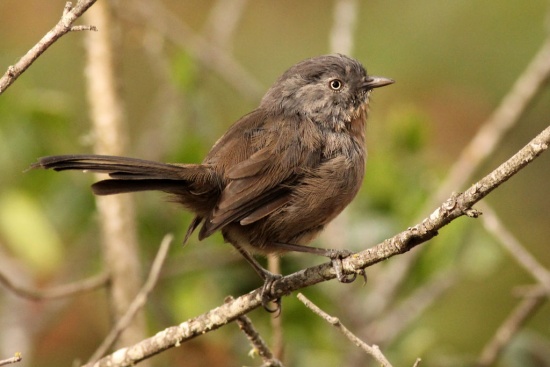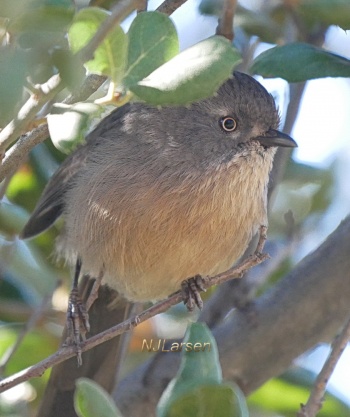
Photo © by bievreJJ
Windy Hill open space preserve, Portola Valley, California, USA, 24 August 2018
- Chamaea fasciata
Identification

Photo © by NJLarsen
Cuyamaca Rancho, San Diego County, California, USA, 14 October 2018
14–16 cm (5½-6¼ in)
- Plainish-brown overall plumage
- Pale yellow iris
- Long tail
- Short, slightly curved dark bill
Both sexes, and juveniles have similar plumage.
Similar Species
The Wrentit is often confused with the Bushtit, another drab species found in similar habitat. A useful plumage feature for separating these two is the distribution of reddish-brown colors: a Wrentit will show its warmest color on the lower chest, which is often a pinkish-brown. Bushtits tend to show cold gray chests with the warmest brown tones found on the head, especially the crown.
With practice the two species are easily separated by behavior and voice, and by habitat. The Bushtit is a social bird, found in loose flocks that fly from tree to tree in the mid-canopy and constantly producing high-pitched chip notes. By contrast, the Wrentit is usually found as a pair of birds or a solitary individual, and will usually stay low to the ground in dense brush. It rarely flies in the open without a direct threat, preferring to retreat deeper within vegetation and make various low-pitched chattering calls.
Distribution
Coastal regions of western North America, from Oregon south through California to northern Baja California, within about 200 km of the Pacific coast. It is abundant in parts of its range. The species is highly sedentary, so much so that the Columbia River is too wide for them to cross, giving the species no records in Washington despite their being common on the south bank of the river in Oregon.
Taxonomy
The placement of this species in the taxonomic order remained a mystery for a long time. It was variously placed in its own family, or within the Sylviidae, Paradoxornithidae or Timaliidae. Recent genetic research has shown that it is the only American member of Sylviidae, the sylviid warblers[1][3].
Subspecies
Five subspecies are recognized[1]:
- C. f. phaea in coastal northwestern Oregon (Columbia River to California border)
- C. f. margra in interior of southwestern Oregon
- C. f. rufula in Chaparral of coastal northern California (Del Norte to Marin counties)
- C. f. fasciata in interior of coastal California from Lake County south to the San Francisco Bay region, then south coastally to San Luis Obispo County
- C. f. henshawi in interior of northern California (inner Coast Ranges and Sierra Nevada) and coastal southern California to northwestern Baja California
The subspecies differ slightly in plumage tone, with northwesternern coastal birds being darker and browner, and southeastern and inland birds being paler and grayer[2].
Habitat
Low brush and chaparral, often near water.
Behaviour
Active and vocal, but rarely visible. The bird often raises its tail while jumping around within dense brush.
Diet
Feeds mainly on insects, but also takes fruit and berries.
Breeding
Breeding season from March to August. A monogamous species, mating for life. The nest is a deep, compact cup made of fibers, bark and spider's webs. It is placed close to the ground among dense twigs of a shrub. Lays 3 - 4 eggs.
Movements
Resident species.
Vocalisation
The call is a varied series of grinding and chattering noises. One commonly heard variation sounds like a ping-pong ball hopping on a hard surface (reducing time between the notes).
References
- Clements, J. F., T. S. Schulenberg, M. J. Iliff, S. M. Billerman, T. A. Fredericks, B. L. Sullivan, and C. L. Wood. 2019. The eBird/Clements Checklist of Birds of the World: v2019. Downloaded from http://www.birds.cornell.edu/clementschecklist/download/
- Gill F, D Donsker & P Rasmussen (Eds). 2020. IOC World Bird List (v10.1). doi : 10.14344/IOC.ML.10.1. Available at http://www.worldbirdnames.org/
- Del Hoyo, J, A Elliott, and D Christie, eds. 2007. Handbook of the Birds of the World. Volume 12: Picathartes to Tits and Chickadees. Barcelona: Lynx Edicions. ISBN 978-8496553422
- Gelang, M., Cibois, A., Pasquet, E., Olsson, U., Alström, P., & Ericson, P. G. P. (2009). Phylogeny of babblers (Aves, Passeriformes): major lineages, family limits and classification. Zool. Scripta 38: 225-236.
- Geupel, G. R. and G. Ballard (2020). Wrentit (Chamaea fasciata), version 1.0. In Birds of the World (P. G. Rodewald, Editor). Cornell Lab of Ornithology, Ithaca, NY, USA. https://doi.org/10.2173/bow.wrenti.01
- Collar, N. & Robson, C. (2020). Wrentit (Chamaea fasciata). In: del Hoyo, J., Elliott, A., Sargatal, J., Christie, D.A. & de Juana, E. (eds.). Handbook of the Birds of the World Alive. Lynx Edicions, Barcelona. (retrieved from https://www.hbw.com/node/59390 on 13 April 2020).
Recommended Citation
- BirdForum Opus contributors. (2025) Wrentit. In: BirdForum, the forum for wild birds and birding. Retrieved 27 April 2025 from https://www.birdforum.net/opus/Wrentit
External Links
GSearch checked for 2020 platform.1



